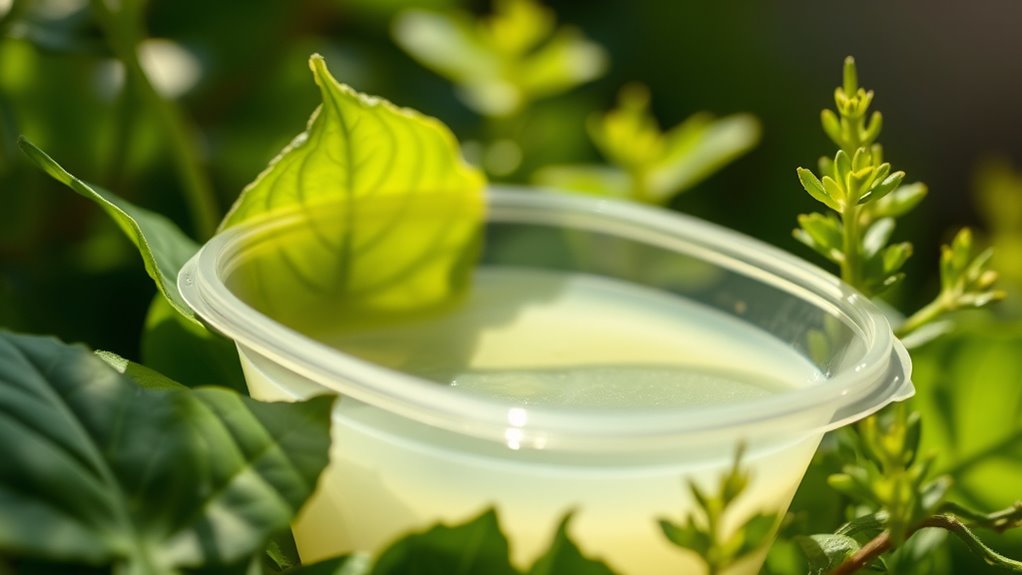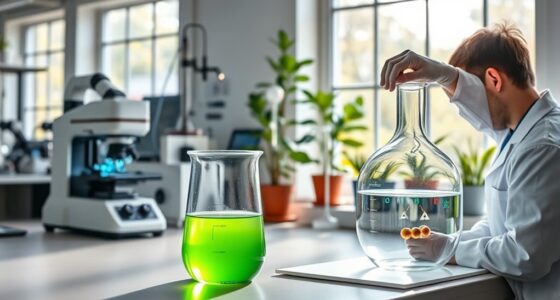Polylactic acid (PLA), a plant-based plastic, is revolutionizing packaging by offering a biodegradable and sustainable alternative to traditional plastics. Made from renewable crops like corn and sugarcane, it reduces environmental pollution and greenhouse emissions. This eco-friendly material is compatible with existing manufacturing methods, making it easy for industries to adopt. As more companies embrace bioplastics, you’ll discover how they’re helping build a cleaner, greener future—keep exploring to see how this shift is unfolding.
Key Takeaways
- Polylactic Acid (PLA) is derived from renewable plant resources like corn and sugarcane, making packaging more sustainable.
- PLA-based plastics are biodegradable, reducing environmental pollution compared to traditional petroleum plastics.
- They can be processed using standard manufacturing equipment, facilitating industry adoption for packaging solutions.
- Using plant-derived plastics supports sustainable agriculture and promotes a circular economy.
- Growing consumer demand and technological advances are expanding the use of PLA in eco-friendly packaging worldwide.

As the world seeks sustainable alternatives to traditional plastics, scientists are turning to plants as a promising source. One of the most exciting developments is the creation of bioplastics like polylactic acid (PLA), which offers a compelling solution to the environmental issues caused by conventional plastics.
By using plant-based materials, PLA provides notable biodegradability benefits, allowing products to break down naturally in composting conditions without leaving harmful residues. This feature substantially reduces plastic pollution and helps protect ecosystems, especially when compared to petroleum-based plastics that persist in the environment for hundreds of years.
The shift toward plant-derived plastics also emphasizes sustainable sourcing. Unlike fossil fuels, which are finite and environmentally damaging to extract, plants such as corn, sugarcane, and cassava are renewable resources that can be cultivated repeatedly.
This means that the raw materials for PLA can be replenished quickly, minimizing the environmental footprint associated with production. By choosing plants that grow rapidly and require fewer resources, manufacturers can create bioplastics that align with eco-friendly practices, reducing greenhouse gas emissions and conserving natural resources.
Using plants as a raw material also offers economic and social advantages. Farmers can benefit from growing crops specifically for bioplastic production, creating new markets and encouraging local economies.
Additionally, because these plants can often be grown in existing agricultural systems, the transition to plant-based plastics doesn’t necessarily compete with food supplies, especially when sustainable agricultural practices are employed.
This approach promotes a circular economy where waste is minimized and materials are reused or safely decomposed after use.
In manufacturing, PLA can be processed using conventional plastic equipment, making it a practical alternative for packaging applications. It can be molded into bottles, containers, and film wraps that are both durable and environmentally friendly.
Moreover, advances in bioplastic production techniques continue to improve the efficiency and scalability of plant-based plastics, making them more accessible to industries worldwide.
Consumers increasingly prefer products with biodegradable packaging, which not only reduces environmental impact but also aligns with their values of sustainability.
As a result, companies adopting PLA can enhance their brand image and demonstrate their commitment to eco-conscious practices.
Ultimately, the development of plant-based plastics like PLA marks a noteworthy step toward reducing our reliance on fossil fuels and curbing plastic waste.
Its biodegradability benefits make it a smart choice for the environment, while sustainable sourcing ensures that production can be scaled responsibly.
As technology advances and demand grows, plant-derived plastics will likely become a standard in packaging, helping us build a cleaner, greener future.
Frequently Asked Questions
Can PLA Be Recycled Multiple Times Without Quality Loss?
You might wonder if PLA can be recycled multiple times without losing quality. During the recycling process, PLA can be reprocessed, but each cycle may cause some degradation, affecting quality maintenance.
While it’s possible to recycle PLA several times, eventually, the material’s properties weaken, requiring proper disposal or repurposing. To maximize its reuse, efficient recycling methods are essential, ensuring the material maintains as much of its original quality as possible.
How Does the Cost of PLA Compare to Traditional PLAstics?
Did you know that PLA typically costs about 20-30% more than traditional plastics? This cost comparison impacts market affordability, making it a concern for widespread adoption.
While PLA offers eco-friendly benefits, its higher price can slow integration into industries already comfortable with conventional plastics. You’ll find that as production scales up, prices may drop, but for now, the cost difference remains a key factor in its market competitiveness.
Is PLA Biodegradable in All Environments?
You might wonder if PLA is biodegradable everywhere. It depends on biodegradability conditions like temperature, humidity, and microbial activity.
In industrial composting, PLA breaks down quickly, reducing environmental impact. However, in natural environments like oceans or landfills, it can take years to degrade, and sometimes it doesn’t fully break down.
What Are the Limitations of Using PLA for Packaging?
Imagine you’re in a time machine, and you’re curious about PLA’s packaging limits. You’ll find that biodegradation challenges, like slower breakdown in certain environments, pose a hurdle.
Plus, supply chain limitations—such as sourcing plant-based materials and scaling production—restrict widespread use. These factors mean PLA isn’t perfect for all packaging needs, especially where quick decomposition or massive production are vital.
You’ll need to weigh its eco benefits against these practical constraints.
Are There Any Health Concerns With PLA Leaching?
You might wonder if PLA leaching poses health concerns. Generally, PLA offers good chemical safety, making it safe for consumer health.
However, high temperatures can cause tiny amounts of compounds to leach into food or drinks, especially if heated excessively or repeatedly. To minimize risks, follow manufacturer guidelines for use and avoid exposing PLA containers to extreme heat.
Conclusion
As you explore plant-based plastics like polylactic acid, you’ll see how they’re revolutionizing packaging. Did you know that PLA production reduces carbon emissions by up to 60% compared to traditional plastics? This significant decrease highlights how switching to plant-derived materials can make a real difference for the environment. By choosing biodegradable options like PLA, you’re helping reduce plastic waste and support sustainable innovation—making a positive impact one package at a time.









